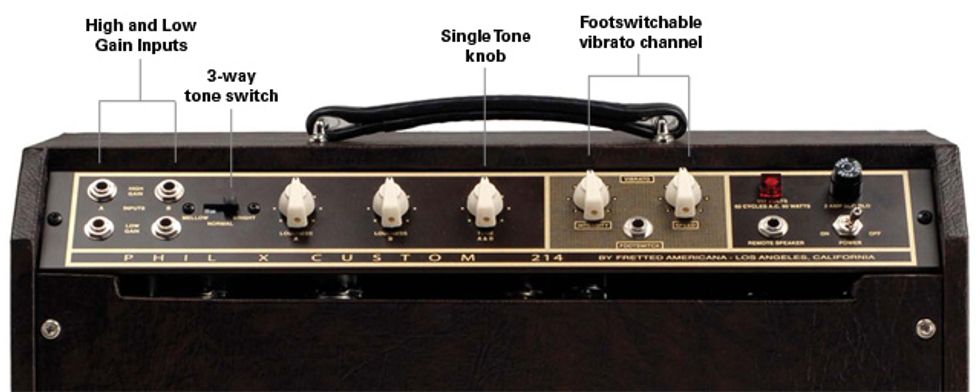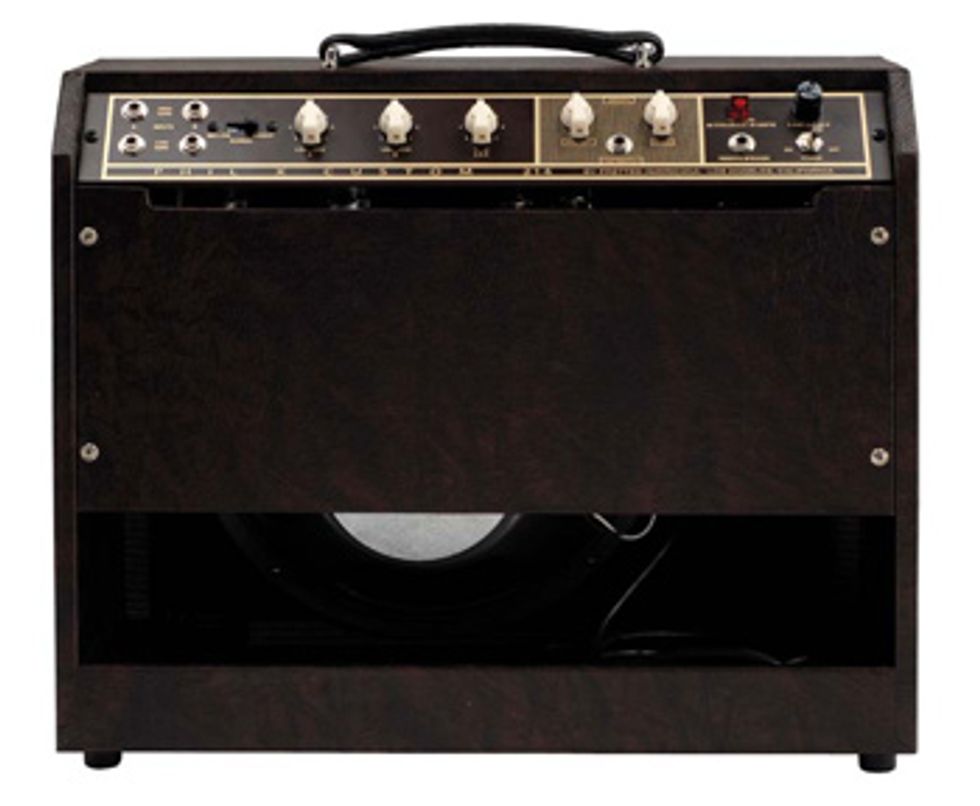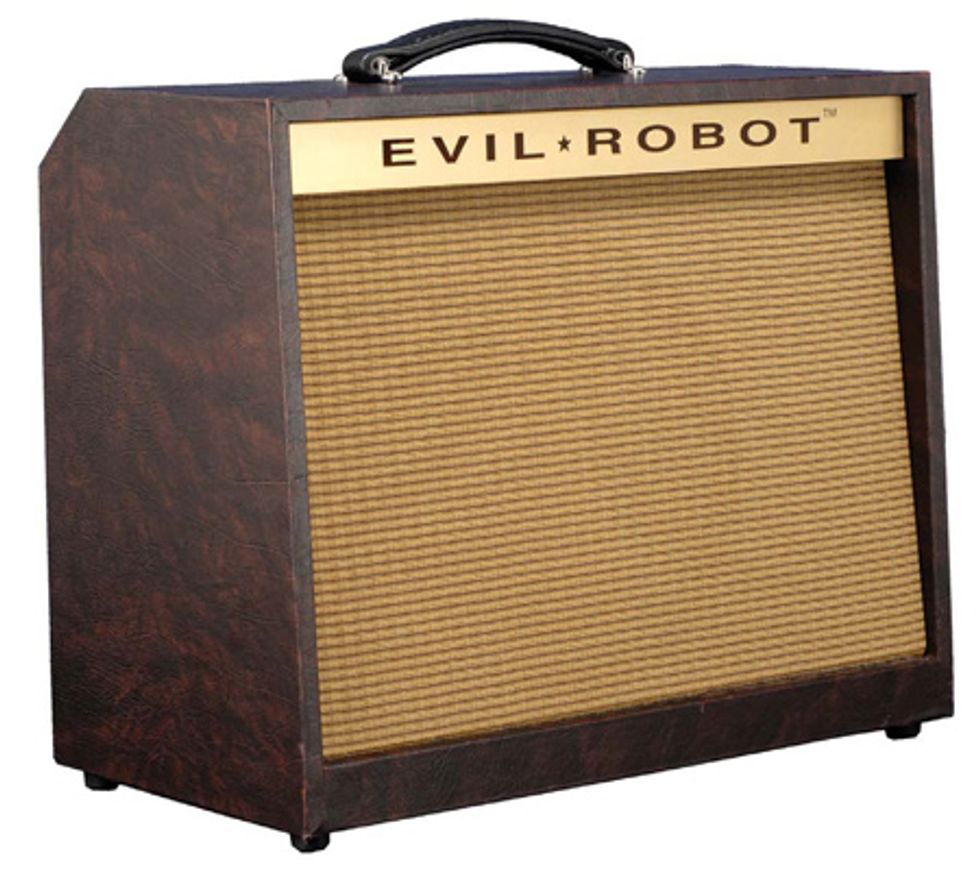| Download Example 1 Raw rock rhythm (Epiphone Sheraton) | |
| Download Example 2 Clean with vibrato (Godin Dorchester) | |
| Download Example 3 Neck roll-off and bridge lead tones (Gibson Les Paul) | |
| All clips recorded with a Chandler LTD1 mic pre into an Apogee Symphony I/O to Pro Tools HD9. SM57 off axis to Evil Robot. Slight addition of Lexicon hall reverb in mix. | |
The decision to build the Evil Robot was prompted by demand from Fretted Americana viewers wanting to know more about the mighty little Tonemaster, an amp that was originally made for accordion. Recognizing an opportunity to resurrect a great design and meet a burgeoning demand (and the reality that Phil’s ancient Tonemaster might not live forever), Fretted Americana brought in engineer John Kasha to design and build an updated version of this classic. Enter the Evil Robot!
A Bionic Clone
While Kasha took care to replicate the Tonemaster’s sound and looks, he made the Evil Robot more robust with modern components. The 40-pound amp is packaged in a 20" x 9.5" x 15" cabinet made of Baltic birch ply and covered in a cool brown vinyl that’s complemented by a gold-mesh grille. Ivory-colored chickenhead knobs and a heavy-duty handle add an air of mid-century authenticity. The hilarious “EVIL ROBOT” logo is prominently displayed on a gold panel where the Tonemaster logo appeared on the original. And production amps will have a gold plate on the back of the semi-open back cab commemorating the amp with signatures by Phil X, Fretted Amrericana owner David J. Brass, and John Kasha.
Powered by a pair of 6V6s, the cathode-biased amp produces 18 watts. A pair of 12AX7s, one 12AU7, and a 6AV6 complete the all-tube signal path, and the true point-to-point wiring (no circuit board) incorporates premium American-made components. The 8Ω 12" speaker is handmade in the US and rated at 30 watts.
The Evil Robot will put you back in touch with the nuances of your instrument—it’s incredibly satisfying to play through, regardless of what guitar you plug in.
From left to right, the control panel consists of four inputs (High and Low inputs for channels A and B), followed by a 3-way switch for voicing (Mellow, Normal, and Bright). Loudness A and B knobs share a single Tone control for both channels, while the Vibrato circuit consists of Intensity and Speed knobs with a footswitch jack located just below. Finally there is an orange power indicator light, remote speaker output, a 2A Slo-Blo fuse, and a power toggle with no standby switch.

Play That Funky Music
To say the Evil Robot is funky is an understatement. Its overdriven, throaty, low-watt voicing will appeal to anyone who digs the sound of Valco, Supro, Airline, or Silvertone amps. But the ER has a lot of style and versatility too. This is an amp that begs to be played and explored with each guitar you plug in. Its clean front end highlighted the personality of each axe I employed over the course of the review, revealing the effects of different pickups, wood, and even picks on the tones leaping from the speaker. The Evil Robot will put you back in touch with the nuances of your instrument—it’s incredibly satisfying to play through, regardless of what guitar you plug in.
The first guitar I tried was an Epiphone Sheraton with Tom Holmes 455s (8.55k in the bridge). Running into the Robot’s Channel A High input with the Loudness A and Tone cranked and the switch in the Bright position, I was rewarded with a lush but ragged and boxy grind in the fashion of Alex Lifeson’s 2112 tone—all at a tolerable volume. I quickly became addicted to exploring picking dynamics, and digging in or backing off was often all I needed to clean up the tone or coax a little grit. I also found that it was great for refining and exploring the details and dynamics of hybrid picking. If you’re a stickler for precision, the Evil Robot will reward the detail and touch in your technique. Likewise, it certainly won’t help hide your mistakes if you’re a sloppy player.
Probing the capabilities of the 3-way voicing switch, I found the Mellow setting quite dark. With the Tone backed down it was a little too mellow for my tastes. But with the Tone at its mid setting, the amp gave me a little more top-end bite that was great for jazz chording and leads.
The Normal setting opened up the ER considerably, and I spent most of my time tinkering with the amp in this mode. Without dedicated bass and treble controls, it can be a balancing act to get precisely the voice you’re looking for. But it’s never difficult to get a great sound, and the range is still quite wide—especially for a low-power amp.
It’s worth noting that the 3-way switch is only a 3-way on Channel A. On Channel B, you only have the use of high and low tone settings. And the 3-way switch is constrained by the Tone knob in the sense that you must back the Tone down to 4 o’clock or so to engage the Normal and Mellow modes. It’s a quirky circuit, but useful and expressive once you get the hang of things.
 Moving on to a Fender Strat revealed
the Evil Robot’s range of clean tones and
spank. I got all the quack you’d ever want
out of the bridge-plus-middle pickup
position, and the neck pickup was biting,
chiming tonal bliss—perfect for serious
chicken pickin’. In the same mode, I tried
my Creation Audio Labs Holy Fire pedal to
see how the amp sounded in high-gain territory.
With the extra boost, the Evil Robot
howled, screamed, and kicked its way into
beautiful fits of musical rage where rich
harmonic feedback knocked me off my
feet. Meanwhile, a Richmond Dorchester
wired with Lace Alumitones helped me
crank out some gutsy slide tones that could
run with the dirtiest old, vintage combos.
Moving on to a Fender Strat revealed
the Evil Robot’s range of clean tones and
spank. I got all the quack you’d ever want
out of the bridge-plus-middle pickup
position, and the neck pickup was biting,
chiming tonal bliss—perfect for serious
chicken pickin’. In the same mode, I tried
my Creation Audio Labs Holy Fire pedal to
see how the amp sounded in high-gain territory.
With the extra boost, the Evil Robot
howled, screamed, and kicked its way into
beautiful fits of musical rage where rich
harmonic feedback knocked me off my
feet. Meanwhile, a Richmond Dorchester
wired with Lace Alumitones helped me
crank out some gutsy slide tones that could
run with the dirtiest old, vintage combos.One of the really special bonuses of the Evil Robot is the fantastic Vibrato circuit. It can be taken out of the chain any time with the included footswitch, but I found myself pretty addicted to the effect over time. Unlike a lot of vibrato circuits, it doesn’t overpower the signal, but remains strong as notes fade. And belting out big power chords or ripping lead lines with a tasteful, controlled vibrato blend really expanded the amps available colors.
The Verdict
In an increasingly airbrushed, homogenized, and antiseptic world, it’s easy to forget that you can’t always model the magic of pushing an amp beyond its limits. The visceral impact of an amp ready to blow is always an inspiration to me. And the funky character that the Evil Robot communicated in this operating environment was right up my alley.
The Evil Robot is overflowing with potential for many kinds of players. It doesn’t do modern scooped mids or endless high gain. But it’s uncommonly responsive to pick attack, drive, and dynamics. The simple but effective circuit and excellent vibrato is more than enough to justify the price, and from what I witnessed, this amp is built to last. It’s almost impossible to capture the mojo of an amp as battlescarred as Phil X’s Tonemaster. But this amp will certainly outperform the original in terms of stability and power. Coming together on a project that many people have been asking for, Kasha, Brass, and Phil X have done an outstanding job.
Buy if...
you want funky, cool, retro tones and more in a stable, solid, compact low-watt combo.
Skip if...
bells, whistles, knobs, and FX loops are an absolute necessity.
Rating...
Street $1595 - Fretted Americana - frettedamericana.com |














![Rig Rundown: Russian Circles’ Mike Sullivan [2025]](https://www.premierguitar.com/media-library/youtube.jpg?id=62303631&width=1245&height=700&quality=70&coordinates=0%2C0%2C0%2C0)









